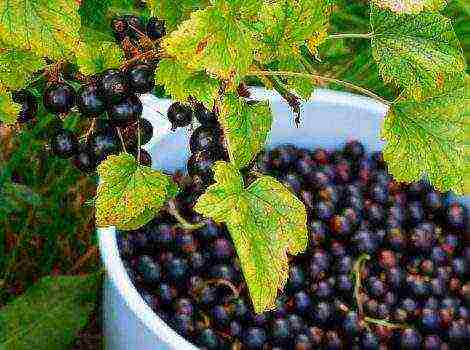Content
In our article, we want to discuss the very best varieties of yellow roses. Probably not to find a more beautiful flower than a rose. Currently on sale there are varieties of the most incredible colors. They are all beautiful in their own way. A real decoration of any rose garden will be yellow-scarlet and yellow varieties, which attract the eye with the brightness and uniqueness of tones.
The best flower is a rose
Roses are perhaps the most popular and sought after flowers in the world. Any gardener has these beautiful plants on his site. Currently, so many varieties of roses have been bred that sometimes it is simply difficult to decide on a color when buying. The varieties of yellow roses are especially popular. They always attract attention with a special inner glow, especially flowers with scarlet tones. Roses won the love of gardeners for a reason. One of the reasons for the popularity of the plant is, of course, the beautiful flowers. Another factor in the general spread of the fashionable trend is the prolonged flowering of modern varieties. If earlier the rose bloomed in May-June, then the re-flowering could only be expected in September. Currently, many varieties have been bred that do not interrupt their flowering. Such bushes delight with their beauty all warm seasons. Particularly noteworthy are the varieties of yellow roses, which are an adornment of any flower garden.
Geisha
Yellow-red roses are incredibly beautiful. They have a special mysterious glow in the evening. Rose Geisha is popular among rose growers. The plant has a very beautiful flower, which, even when fully blooming, does not reveal the center. And this is due to the fact that the petals have a different structure. The lower ones are very large and wavy, they bend down. And the upper ones are much smaller, there are many of them, they are collected in a dense bud. The Geisha rose stands out from other flowers thanks to its extraordinary petals. The height of the bud reaches six centimeters, while the diameter when fully blooming is twelve centimeters. The petals in the flower are so densely arranged that it seems as if they are very cramped there. This is an important point when cutting a flower, as the rose retains its shape ideally for seven to ten days. The flower emits a subtle scent. In calm weather, you can feel how the Geisha exudes a sweet, delicate, very light aroma.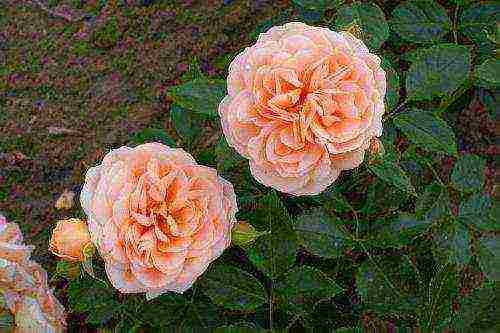
The bushes reach a height of one meter. The plant has strong stems that support large buds. The beauty of the flowers is emphasized by the dark green leaves.
This variety is also planted in greenhouses for further cutting. In indirect lighting, the buds stretch even more, become taller, the stem lengthens, and the petals become completely white.
This variety has advantages such as resistance to diseases and freezing. The plant winters well even in places with harsh climatic conditions, but it needs to be covered for the cold period. The hybrid tea rose is completely unpretentious, at the lowest cost you will get beautiful lush flowers.
Pilgrim variety
Rose Pilgrim has a beautiful delicate flower of light color. The inner petals are painted in a more saturated color, while the outer ones are almost white. This creates a glowing effect. The flower has a very delicate and discreet appearance, it goes well with other varieties.
Many breeders believe that the Pilgrim rose has one of the most perfect buds. As a hybrid form, this rose has a very unusual scent of a mixture of myrrh and tea rose. These shrubs are great for decorating and landscaping parks and gardens.Roses bloom with huge clusters of inflorescences that do not crumble for a long time. Gradually, the first flowers are waiting for the last to bloom.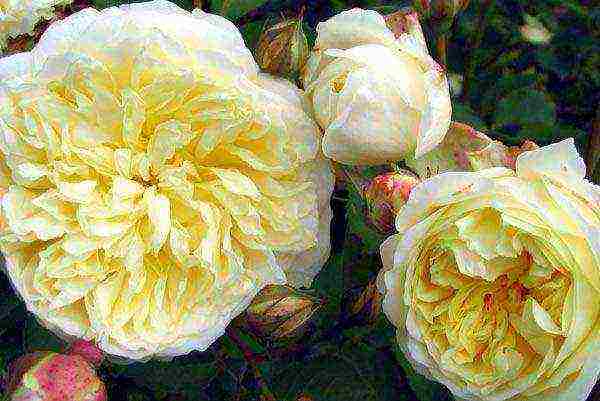
The bushes themselves are very lush, strong shoots and shiny waxy leaves. Breeders claim that the plant is between 105 and 305 centimeters tall. However, it is difficult to grow a bush of this size under normal conditions. Usually the plant is one meter high.
The rose should be planted in warm, sunny areas where there are no cold winds. The plant prefers moist but drained soil. A park rose needs regular feeding, weeding and watering. Usually the bushes are fertilized in the spring and in the middle of summer. Plants are usually watered once a week. Pruning is done in the spring before the buds awaken.
Decor Harlequin
Rose Decor Harlequin fully lives up to its name, changing its appearance. On one bush, there is practically not a single similar flower. We can say that these are scarlet roses, pink-crimson, strawberry, yellow. Different shades replace each other on the outer and inner parts of the petal. Very often, light stripes and blotches are found on the surface of flowers of this variety. Terry buds are striking in a variety of shapes. The petals have a slightly corrugated edge, which creates an airy effect.
Rose lovers often associate this variety with a chameleon, and the color of the flower is called catchy. Such scarlet roses can decorate any flower garden.
However, the Rose Decor Harlequin boasts not only bright and beautiful flowers, but also high resistance to frost and disease. Flowers reach nine to eleven centimeters in diameter. They are arranged one at a time, as well as inflorescences. The rose is resistant to heat and rain. At the exhibition in Rome, the variety was awarded a gold medal. The plant is versatile in use, it looks very advantageous in hedges, single planting, in isolated groups.
Arthur Bell
Considering the varieties of yellow roses, you should certainly remember such a variety as Arthur Bell. The most beautiful floribunda is still very popular in northern Europe and Great Britain. Rose Arthur Bell blooms early and repairs fairly quickly. The flowers exude a very strong and intense fruity aroma. However, the variety has one serious drawback - the flowers fade. At first they have the most beautiful bright yellow color, but then very quickly turn pale and acquire a lemon and cream shade. Each bud consists of twenty petals ranging from cream to yellow. The bush is quite tall with dense, tough foliage. The flowers are very large and weather resistant. Rose Arthur Bell has few rivals that can match her scent. Its resistance to powdery mildew and spotting generally makes the cultivar excellent for keeping.
Worm Vicious
Rosa Worm Vicious belongs to the traditional English hybrid tea varieties. Its captivating beauty lies in its bud shape and coloration. Yellow-red roses change their color depending on the climate and weather. In the center of the bud, as well as outside, the petals are darker in color. In cooler weather, the flower becomes brighter.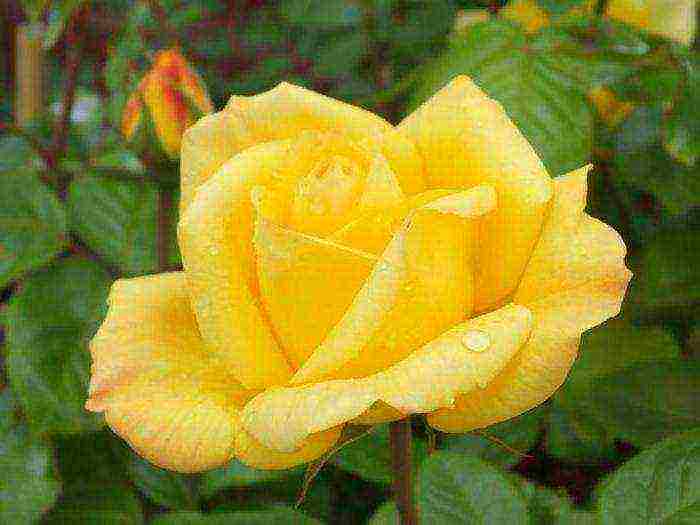
The buds consist of 30-35 petals of a mixed pink-apricot color. In hot weather, the flower burns out very quickly and takes on a creamy color. Roses from large buds turn into a beautiful flower that retains its shape for a very long time.
Rose Worm Vicious has single flowers or inflorescences. During mass flowering, up to three buds can be located on one peduncle. The bushes bloom all summer and even autumn, without fear of wind and rain. This rose variety is disease resistant.
It is worth noting that Worm Vices is the owner of 24 international awards. It has good gardening qualities that have made it so popular all over the world. The bushes are 160 centimeters high. Although the variety belongs to the hybrid tea species, the plant itself does not stretch or bare at the bottom. The bush has a harmonious shape, branched, beautiful, blooms very profusely.Often whole inflorescences appear. But this is not reflected in the size of the flower, which reach ten to twelve centimeters in diameter. They perfectly tolerate rains and hot weather.
The apricot-orange tones of the rose have found many fans of this variety. An important fact is that roses do not fade or fade. They even bloom neatly, the petals gently fall off without drying. So these yellow-red roses will be a decoration of any garden.
Gold Wedding
Rose Gold Wedding refers to unpretentious and highly flowering varieties. The bushes reach a height of ninety centimeters, and about half a meter in diameter. The plant is compact enough, it has strong shoots. The rose is good for cutting. Flowers are collected in clusters of three to five buds. These varieties of yellow roses look very beautiful in the garden. Double flowers are colored golden yellow and exude an unobtrusive, very light aroma. The advantage of this variety is continuous flowering throughout the season. The plant has an average resistance to rain and disease.
David Austin varieties
In recent decades, gardeners have an excellent opportunity to enjoy not only tea and garden varieties, but also wonderful pompom roses, which seem to have just left the old Flemish paintings. Many now popular varieties have appeared thanks to the English farmer David Austin. Back in the fifties, he crossed tea and garden varieties with floribunda roses, as a result, many new color schemes were obtained, including yellow species. New varieties could re-bloom or bloom all the time. In addition, they were more resistant to cold weather and disease. It is these varieties that are the dream of any gardener.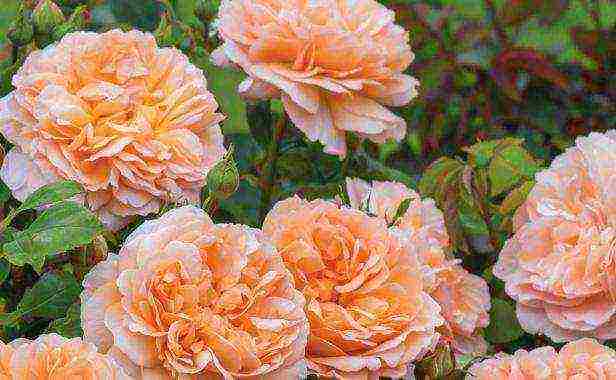
Hybridization of new varieties takes at least eight years. Every year, David Austin creates new varieties. The idea of the breeder is that each new species was more and more adapted to any weather conditions and needed minimal maintenance.
Those who are a fan of David Austin varieties need to know some of the nuances of growing roses.
All species come from foggy Albion, and therefore do not really like direct sunlight. Therefore, it is better to plant them in partial shade.
There are many varieties of David Austin. Its climbing roses can be used to decorate walls, gazebos, arches, pergolas. A characteristic feature of such plants is the flowering of buds from the very base of the stem to the tips. A similar phenomenon is not found in other climbing varieties, which have bare pagons with flowers at the very edge of the branch, which looks ugly.
English roses need breathable soils. When planting, it is recommended to add humus and compost.
Modern gardeners are very fond of floribunda roses. Their color palette in English varieties is incredibly wide. In addition, they exude an unmatched scent. Unlike other varieties, they are incredibly fragrant.
Corrugated roses are very beautiful. Many bred varieties can withstand frosts of up to forty degrees under light cover.
Ground cover species are also good, with long shoots covering the ground. They do not require huge areas, but at the same time they constantly bloom and delight with bright colors, creating floral carpets.
I would like to note that David Austin's varieties are significantly different from other roses. If you love these flowers, you should definitely have an English rose in your garden. Plants bred by David Austin change their aroma throughout the day depending on the weather, humidity, temperature. In the morning hours, they smell completely different than in the evening.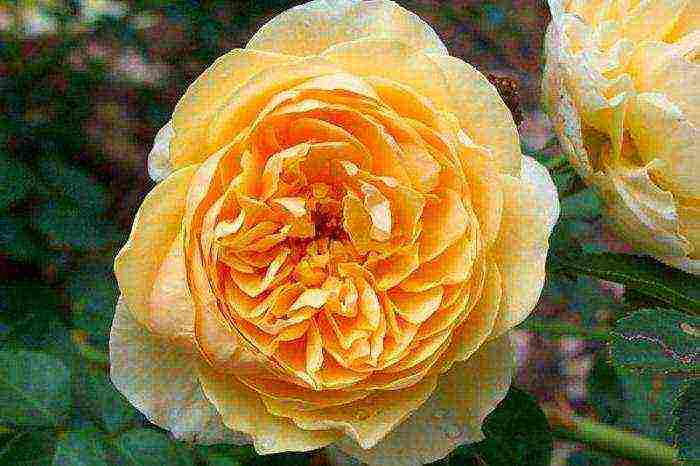
The lush shape and size of the flowers is also striking, some of them reach fifteen centimeters in diameter. This is something amazing.
Some varieties of David Austin
At one time, David Austin was struck by old French roses. He wanted on their basis to get new varieties that will bloom all season and at the same time have an amazing aroma and an incredibly beautiful flower. I must say that the farmer managed to make his dream come true.He created a large number of varieties with the finest qualities, which became famous all over the world.
So, in 1980, a new variety of yellow rose appeared in the arsenal of David Austin, which he named after his friend Graham Thomas. This species has a unique shade, rarely found in roses.
The most famous varieties include:
- Constance Spry.
- Evelyn.
- Eglantune.
- Golden Celebration.
- Gertrude Jekyll.
- Mary Rose.
- Graham Thomas.
- Charlotte.
- Pat Austin.
- Molineux.
- L.D. Braithwaite.
- Scepter'd lsle.
Gold grade
Among the yellow varieties, the Golden Celebration rose stands out. It has just giant globular flowers on drooping branches, painted in a copper-yellow color. This shade is unique to the English rose. Examining the rose closely, you can see that an unusual effect is achieved due to the presence of small pink spots on the petals on a yellow background. Well, one cannot remain silent about a strong beautiful smell at all. This variety combines resistance to disease, elegance, beauty, strength. This is one of the best views of David Austin. The bushes bloom very profusely with proper care. Flowers are dense and large. They have combined the shape of an old look and a completely modern color.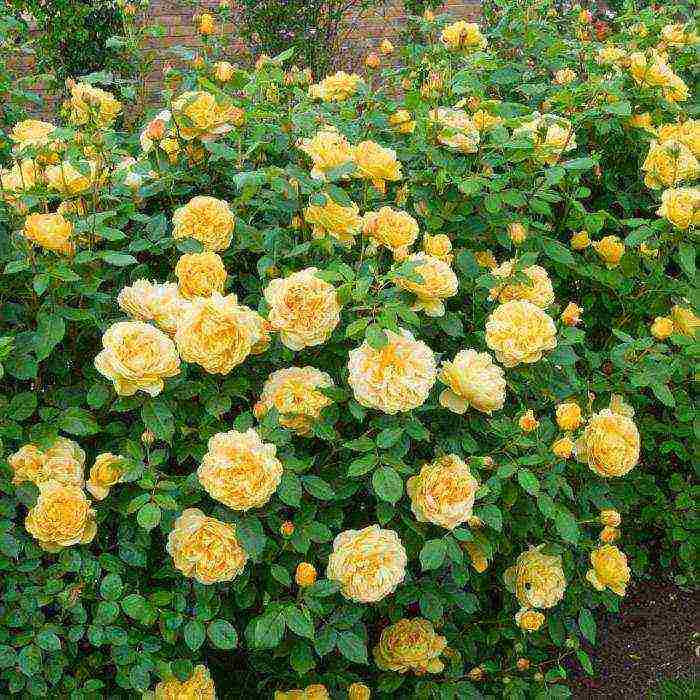
This variety is presented in cream shades, egg yellow, peach, copper yellow, pink. The aroma is described as fruity, spicy. Flowering begins in early summer, after which periods of re-blooming of roses are regularly repeated. Golden Celebration bushes reach one and a half meters in height. The leaves of the plant are dark and tough, the lashes are moderately thorny.
Thomas Graham variety
Of the yellow rose varieties, Thomas Graham is the most popular. This phenomenon is quite understandable, since there are few species that can boast such a beautiful and pure yellow shade. The flowers of the autumn plant are large and cupped, smell like a tea rose.
This variety can be described as the most volatile and inconsistent in terms of bud shades. Flowers range in color from bright yellows to peach. But with age, they fade and become much lighter.
Flowers are formed in a cluster, flowering begins in early summer, followed by a wavy, moderate flowering. The bushes have arched branches with dark green leaves. The variety belongs to tall plants. In cold climates, the bushes grow up to one and a half meters. And in hot countries, the plant produces whips up to three meters in length, they can be launched on supports. In temperate climates, bushes can manifest themselves in different ways.
English roses
Unfortunately, not all David Austin varieties are represented on our market. Although his roses have long been widely used in parks and gardens. They are good because they very quickly create high flowering arrays. Some varieties are wonderful for forming hedges. And shrub species will decorate any, even the most sophisticated, flower bed.
Some varieties are even used for container growing. Such roses take root well in pots and flowerpots. And for the winter period, such plants are buried under the shelter with all the garden bushes. Austin himself advises planting roses in groups, since all its varieties are compatible in color.
But as for blooming, roses are the very first to bloom, which is their advantage. In June, they already bloom safely. This means that you can soon count on the reappearance of peduncles.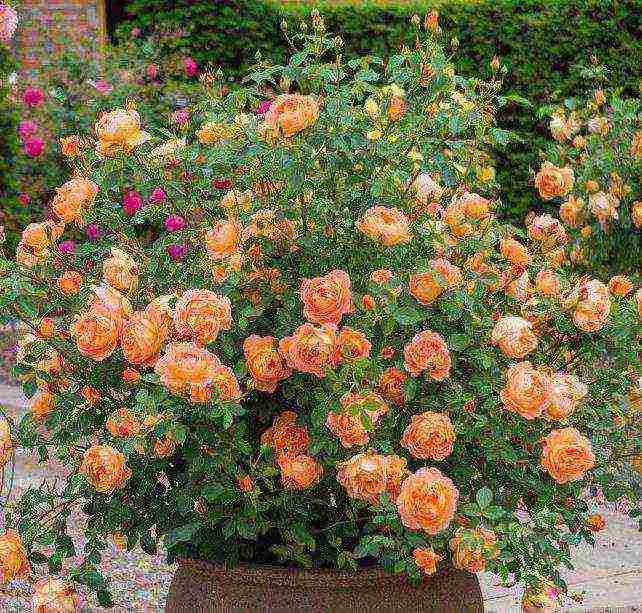
Almost all Austin varieties are shade-tolerant, so they feel great in partial shade. Three hours of direct sunlight a day is enough for them.
However, with all the positive features of Austin varieties, there are some disadvantages. Roses are not resistant to excessive moisture and rain. If during the flowering period there are showers, then you may not enjoy all the beauty, since the flowers simply do not open and begin to rot. Wet buds lack the strength to bloom.
Rains have a very detrimental effect on pompom English roses.Their petals stick together from water and do not open. However, you should not focus too much on this, since, in principle, there are no ideal varieties, each has nuances. Roses by David Austin undoubtedly deserve close attention.
If we talk about yellow monochrome gardens, then I have not yet seen a garden under such a motto, and if we talk about rose gardens (which is closer to me), inhabited only by yellow roses, then this, in my opinion, is a completely useless idea. By a rose garden, I mean not only flower beds, rabatki or rings of a classical layout, but the totality of all plots. I had such a sad experience with one large rose garden. The range was even wider - from yellow-cream to salmon-coral. He immediately seemed boring to me, but I could not convince the customers of their persistence, and they got bored only after 2 years.
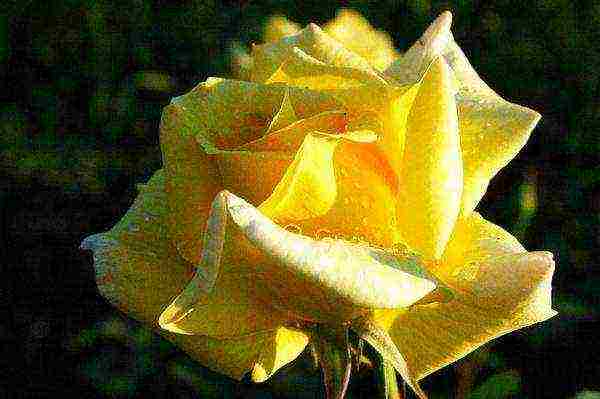
The yellow rose is beautiful. The yellow rose garden is boring
I am already writing the third article on the monochrome boom in gardening, I am always worried and cannot understand in any way who is going to live in such gardens, for example, in yellow? And in red? I walked through the White Garden relatively easily - apparently, there are associations with our winter landscapes. But why, then, are we so impatiently awaiting summer and regret that it is too short?
I can perceive the blue rose garden as unique because rarities will be collected in it. This happens, and it will have value, at least a collection or cognitive, and with a thoughtful approach, you can achieve the expressiveness of such a garden. But I have already come to a dangerous line; I know how much the yellow scale is loved, and I remember in what space the main part of our citizens is looking for harmony with nature.
I consider all undertakings of this kind to be artificial self-restraint, and even under the influence of alien ideas. I admit that such a path can lead to the achievement of something extremely beautiful or unique, but it is always the path of talent. I would be glad to be mistaken, but in our country, as a rule, even noble ideas, taking on a mass character, produce only parodies.
If we are talking simply about a flower garden of finite sizes, where flowers of a yellow scale are planted, then, in my opinion, this is not worth such an active discussion, at least in the form of a campaign. I think the most correct approach is if a person plants what he likes today. When he realizes that he has not received a dream in a real form, let him change something in himself and in his flower garden - then empirically, perhaps, he will come to harmony. And only when he realizes that he has not reached harmony, he will come to a landscape designer and will be able to formulate the subject of his search. Even if we jointly develop several models of the most beautiful flower beds, we cannot seriously expect that we will help someone create a yellow garden where a person will be in harmony at least with himself. Where in such a garden can a person find a place to think about eternal values?
I will tell you about the best varieties of yellow roses from different garden groups, and I choose only pure yellow and exclude shades of amber yellow, coral and orange.
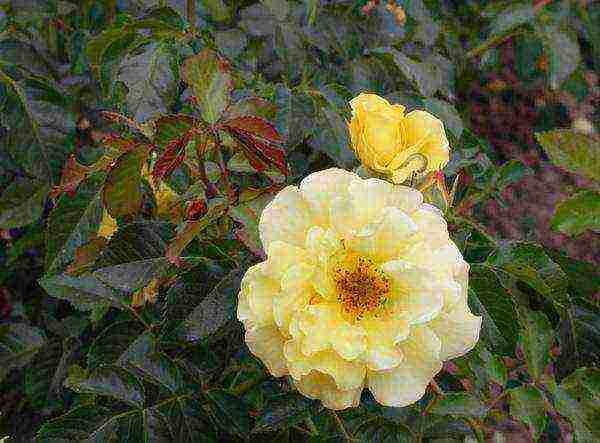
Lichtkonigin Lucia
Among
scrubs despite its age, it does not lose its popularity
‘Lichtkonigin Lucia’
(W. Kordes'Sohne, 1966) with bright yellow flowers. Small dense inflorescences adorn the bushes throughout the season and give a delicate aroma. The advantages of the variety include a bright and long-lasting color, decorative foliage, general stability and high winter hardiness. Some disadvantage can be considered too rigid habit - the plant has straight and strong shoots up to 1.5 m high.
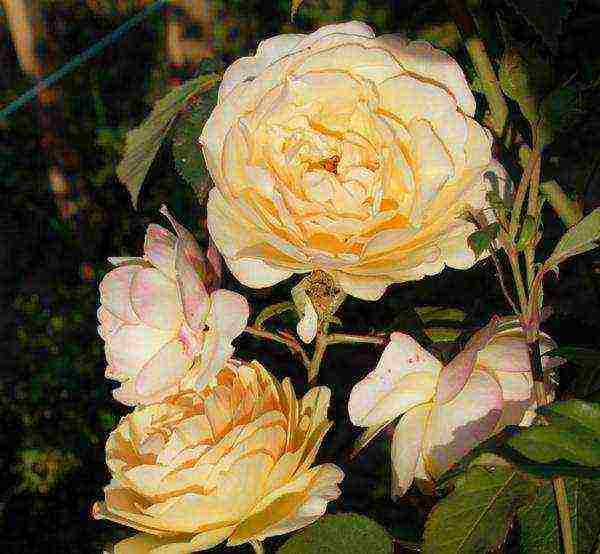
Graham Thomas The purest and most persistent yellow among english roses has the cultivar 'Graham Thomas' (Austin, 1983). The thick doubleness, pronounced cupping of the flower and the sweet aroma attract the attention of numerous fans. The bushes are straight, up to 1.4 m high, branch well and, unlike many English roses, do not fall apart.
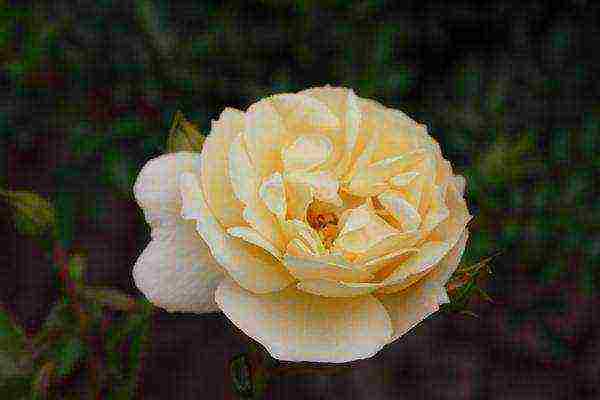
Sonnenschirm
Bright yellow flowers among
ground cover not easy to find. Perhaps the grade
‘Sonnenschirm’
(Rosen Tantau, 1993) is the only one. The planting of this rose in contrast to the bluish-purple ‘
Lavender dream
’(Interplant, 1986) and’
Coeur farouche
'(Delbard, 1994).
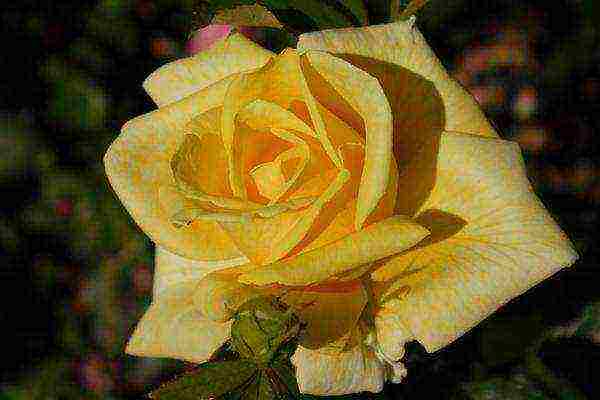
Berolina
Among
hybrid tea roses there are numerous examples of varieties with yellow flowers. Lovers of the classic flower shape can be recommended the variety
‘Berolina’
(W. Kordes'Sohne, 1986), and I want to present the options for the cupped addition in three varieties.
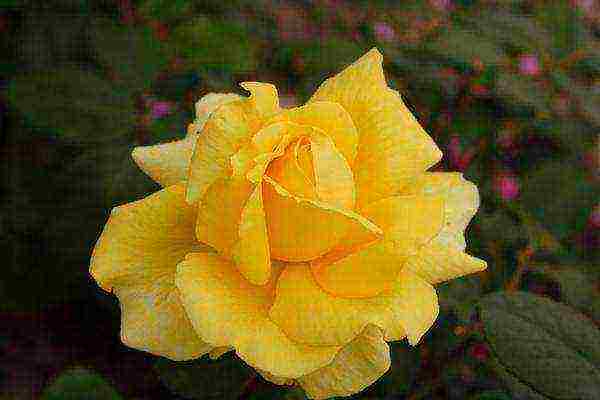
Gina Lollobrigida The outer tiers of the ‘Gina Lollobrigida’ bud (Meilland, 1989) unfold to a flat flower, and the rest of the petals form a bowl, making the flower appear lush and large (up to 13 cm in diameter).
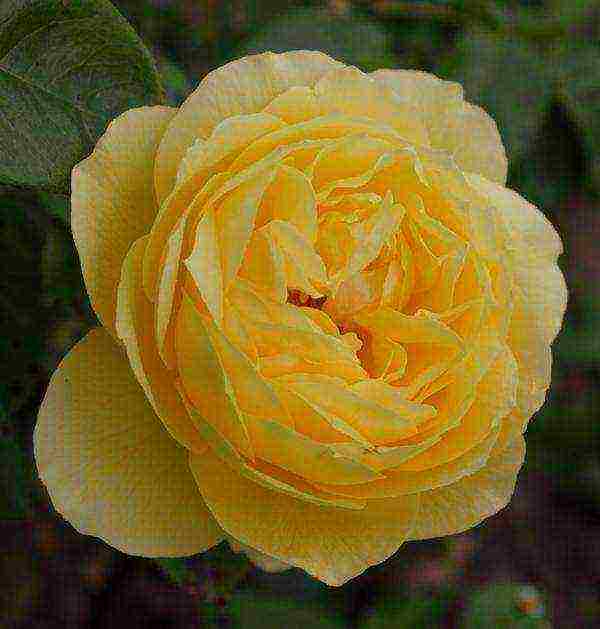
Souvenir de Marcel Proust 'Souvenir de Marcel Proust' pleases not only with its radiant yellow color, cupped shape, but also with a strong aroma of complex shades (lemon balm, pear, cinnamon, sandalwood).
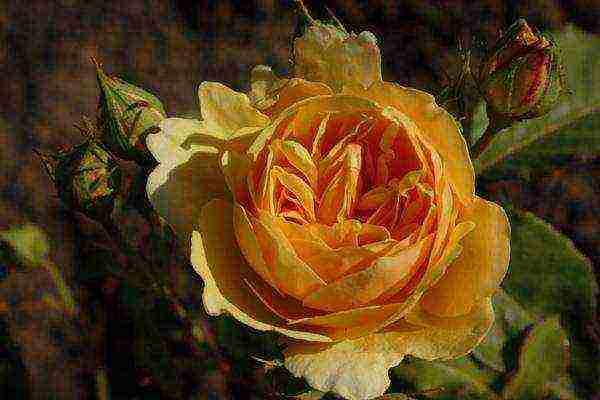
Candlelight Numerous ‘Candlelight’ inner petals (Rosen Tantau, 2001) form an intricate pattern in which signs of symmetry and sometimes a quartered shape can be seen (4 centers).
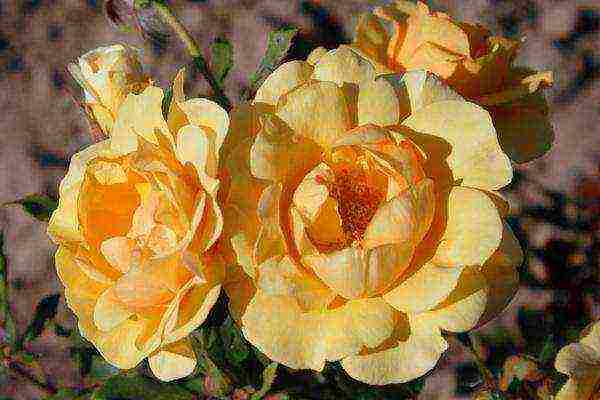
Benita
Floribunda rose
'Friesia'
(W. Kordes'Sohne, 1973) with non-fading and fragrant flowers is widely known in Russia, and such excellent varieties as ‘
Benita
’(Dickson, 1995) and’
Comtesse du barry
'(Meilland, 1996) have only become available in recent years.
Tidy ‘Benita’ bushes with bright blossoms are desirable in any garden, and ‘Comtesse du Barry’ can even add to the collection of curiosities. For example, I do not know of another variety with this inflorescence shape. Numerous medium-sized cupped flowers form such dense inflorescences that they look like huge balls. The leaves are very dense, leathery and few of them, therefore, with abundant flowering, they are almost invisible.
There are much more yellow roses than are considered here, but I tried to bring extraordinary varieties that have their own distinctive features and are not similar to others.
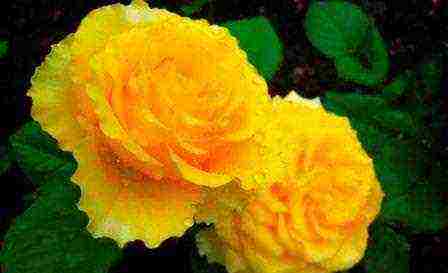 Lush roses have won the love of gardeners all over the world, they are grown in parks, in suburban areas, and are also sold in flower shops in the form of bouquets. Especially good are yellow flowers, which exude a delicate aroma and are relatively unpretentious thanks to the efforts of breeders.
Lush roses have won the love of gardeners all over the world, they are grown in parks, in suburban areas, and are also sold in flower shops in the form of bouquets. Especially good are yellow flowers, which exude a delicate aroma and are relatively unpretentious thanks to the efforts of breeders.
There are many varieties of yellow roses that are suitable for growing in many parts of the country. These varieties not only decorate the site, but are also resistant to adverse environmental influences.
The best varieties
Yellow roses can be grown even in the northern regions, the main thing is to choose the right variety of this amazing plant. The table below shows the names of varieties that are distinguished by their beauty and undemandingness.
| Name | Description | Care features | Resistant to garden diseases and cold |
| Graham Thomas | This rose has a unique and pure yellow hue, blooming throughout the summer season. A climbing bush up to 1.5 meters high fills all the space allotted to it, evenly distributing its flowers over arches, arbors or walls | The plant needs feeding and shelter for the winter, and it must also be cut off in a timely manner. | The variety is resistant to most diseases. Winter hardy |
| "Mary Rose" | Yellow rose from the collection of the English grower David Austin. The cupped yellow-orange flowers have a delicate fruity aroma and remain neat after heavy rains or droughts. The bush is powerful, branched | The described variety of roses needs to bend the shoots, as well as to build a simple shelter for the winter | The bush is susceptible to black spot disease, but is resistant to fungal infections. High winter hardiness |
| "Kerio" | The bright yellow small rose has a mild aroma. It belongs to the hybrid tea varieties of the flower, the bush is tall and erect. | Needs shelter for the winter and pruning of shoots | Susceptible to most diseases in unfavorable years. Average winter hardiness |
| "Yellow Rose of Texas" | Apricot-colored roses with dense petals. Traditionally used for making bouquets. Bushes are compact, weakly branched | Care for this variety is the same as for the above varieties. | High resistance to cold and disease |
| "Golden Showers" | The unpretentious and long-blooming rose is famous for its golden flowers with wavy petals. Re-flowering occurs in autumn. The bush beautifully braids walls, gazebos and other supports | The plant needs a garter, as well as regular feeding and protection from the cold. | Average resistance to cold weather and garden diseases |
| "The Pilgrim" | One of the most beautiful English roses, flowers of a delicate yellow hue have silky petals. Medium-sized, upright bush | This type of rose requires attention from the grower. It is necessary to cut off shoots, feed the plant and cover for the winter. | High winter hardiness and disease resistance |
| "Golden Celebration" | This rose has huge amber-colored globular flowers that exude a strong fruit scent. Sprawling bush, its size directly depends on the climate | Like other varieties, it needs pruning shoots and winter shelter. | The bush is prone to black spot disease. Winter hardiness is high |
| "Warm Wishes" | The flowers are red-yellow, the bushes are compact. Roses with a spicy scent bloom from pointed buds and retain their shape for a long time | The plant needs not only care, but also good protection from frost. | The variety is prone to freezing in severe winters. Average disease resistance |
| Arthur Bell | bright yellow flowers resemble lemon fruits, the bush is tall. In hot weather, roses turn creamy, which is their disadvantage. | Care for this variety is the same as for previous varieties of roses. | Medium disease resistance. High winter hardiness |
| "Rugelda" | The flowers are yellow with red edges, opening from scarlet buds. Thorny bush, reaches a height of up to 2 meters in favorable weather conditions | Be sure to cut off the shoots and feed the plant. | Average resistance to cold and disease |
| "Gold Symphonie" | The small rose is characterized by golden flowers that bloom profusely until autumn. Grows both in gardens and in pots | Caring for a room rose consists in a timely transplant, watering and feeding the bush, as well as in transferring the plant to a cool room for the winter. | The variety is resistant to fungal infections, average winter hardiness |
| "Friesia" | Lemon flowers keep a beautiful shape for a long time, the bush is compact. However, such a rose quickly crumbles, and the gap between flowering is quite large. | In addition to standard care, it also requires good shelter in the cold season. | Average resistance to disease and cold |
Yellow roses first appeared in the Middle East several centuries ago and since then breeders from all over the world have received many varieties of this beautiful flower.
Thanks to the collective efforts of specialists, the plant has become unpretentious, resistant to the adverse effects of the environment. The flowers, which had no scent before, now have a fruity scent that attracts the attention of connoisseurs of yellow roses.
Yellow climbing rose: growing (video)
What does the yellow rose symbolize?
The flower of the golden hue is most often associated with people with separation. Still, a yellow rose does not always mean a request to forget about betrayal or parting, such bouquets are given with wishes of fun and joy, and they are also presented as a symbol of the conclusion of peace. Therefore, you should not refuse the yellow roses presented to you because of popular prejudices.
Often, golden flowers are given to artists and outstanding personalities, which is approval and admiration for their gift. As a gift, lemon or amber roses are suitable for girls, as this color is associated with youth and beauty. Mature women are presented with light yellow flowers that emphasize their nobility. The yellow flower symbolizes not only goodbye, but also wealth. In different countries, people associate it with different things, for example, in Japan this color means happiness and respect.
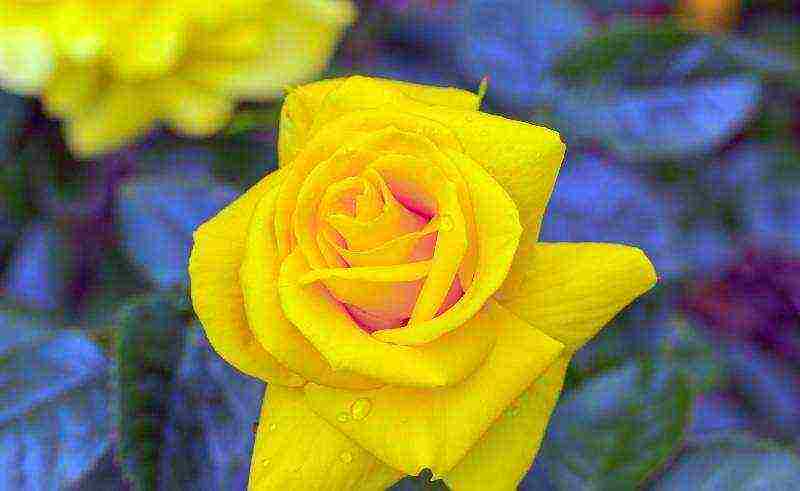
Despite the fact that many are afraid to present yellow roses to their relatives, they buy them for colleagues and celebrities. So, a bouquet of lemon flowers can be presented to a person during a solemn event, thereby wishing him fame and career growth.A lot of yellow roses are a great gift for an anniversary. A catchy and memorable gift is perfect for a colleague, girlfriend or close relative. Do not forget that yellow also symbolizes optimism and has a beneficial effect on the human psyche.
In winter, sunny flowers serve as a reminder of the warm summer, you can present them to sick friends with a wish for a quick recovery.
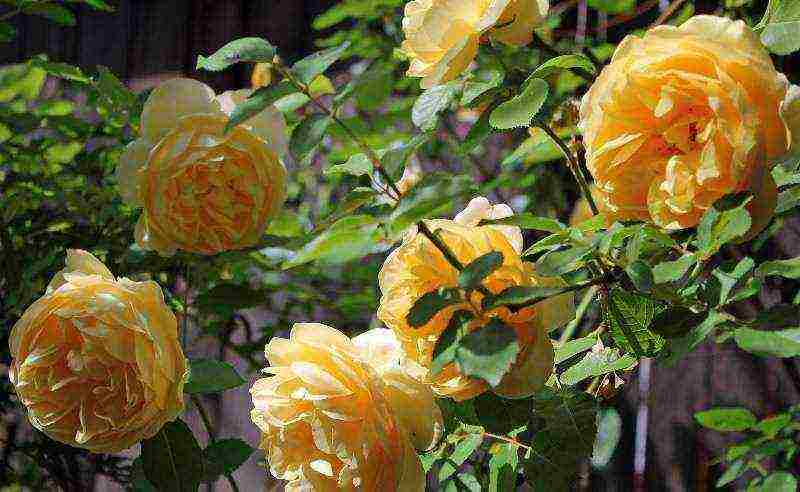
Combination rules with other plants
Despite its unpretentiousness, the rose is demanding of its "neighbors" from the plant world. "Queen of Flowers" is successfully combined with the following ornamental shrubs:
- lilac;
- sea buckthorn;
- yellow acacia;
- dogwood.
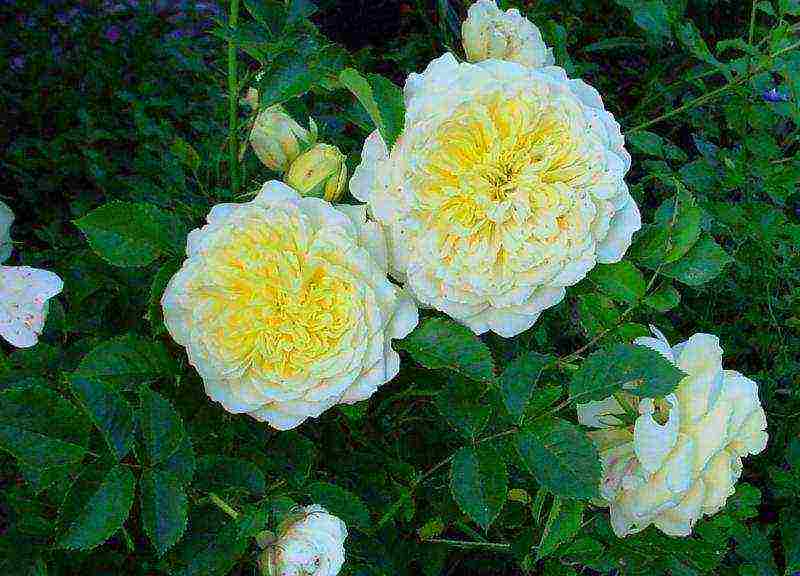
Lilac color in combination with yellow enhances the splendor of the rose garden, and blue enhances the beauty of the flower. Look great next to yellow roses and conifers:
- small spruce;
- thuja;
- juniper.
The yellow rose looks amazing against the background of blue firs and other conifers. It is important to know that they are planted from the north side, otherwise the "queen of flowers" will experience a lack of sunlight. Dwarf conifers and spherical thuja are especially good.A shrub yellow rose against a background of lush greenery looks the most advantageous, beautiful flower beds will decorate a suburban area. Growing well next to the "queen of flowers" and perennials - lavender, bell, delphinium, blue asters.
Companion plants should not compete with roses. Similar growing conditions involve planting in an open, sunny area, loose fertile soil and generous watering. Too aggressive crops will absorb large amounts of moisture and nutrients from the soil, thereby damaging the roses.
The easiest option is to plant low carnations of any color other than yellow in the rose garden. White and red flowers look good. Undemanding blue bells will add variety to a one-color rose garden, and magnificent clematis will favorably emphasize the beauty of lemon roses. These flowers are suitable as a background for scrub varieties, hybrid tea roses.
Lupins, decorative cereals, phlox are also suitable as a suite for the "queen of flowers". Golden roses look good next to decorative bows and lilac delphiniums. It should be noted that the yellow-burgundy rose looks beautiful against the background of undemanding white phloxes, they do not have powerful roots and do not interfere with the bloom and growth of the bushes. If you want to create a neutral background for yellow roses, then use a simple and effective landscape design solution - planting flower spikelets of herbs.
Azure and green tones will emphasize the lush beauty of the rose garden, and whispering brooms in the wind will make the composition interesting and special. Cereals are also planted in the foreground, which gives the flower garden a touch of romance and tenderness.You can also fill the space between yellow roses with the help of well-known annual plants - forget-me-nots, petunias, verbena. They will add beauty to the flower garden and will delight you until the fall.
How to water roses (video)
A colorful, sunny rose is good not only for its fragrance, it adds notes of vitality and fun to the flower garden. Resistant to frost and garden diseases, the yellow “queen of flowers” has won the hearts of many flower growers from all over the world.
It is easy and simple to create beautiful compositions with the help of it, and the combination of bushes with many ornamental plants makes the rose a favorite flower of most people.
Gallery: yellow roses (25 photos)
In order not to lose the material, be sure to save it to your social network by simply clicking on the button below:
Attention, only TODAY!
Reviews and comments
The best varieties of yellow roses
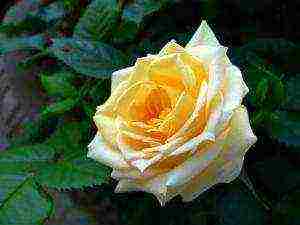
More than 50 years after the breeding of the Leverkusen variety, work continues to obtain, on a scientific basis, a winter-hardy yellow shrub rose. The Morden Sunrise rose, bred in 1999, with rich yellow flowers and pink edges, the bush grows no more than a floribunda. The Tahitian Moon rose is considered a promising rose, introduced by the breeder Lim in 2004.It grows vigorously, forming a bush 150 cm high. Light yellow flowers adorn it all summer long, and by the end of the season, a slight pink color appears along the edges of the petals.
Growers are expected to soon have a reliable winter-hardy rose as tall as Leverkusen, blooming profusely like Tahitian Moon, and dazzlingly bright yellow flowers. We would like to present a series of the best varieties of yellow roses that will definitely surprise you with their beauty.
LITTLE RAMBLER
Class: scrub
Pink colour
Flower size: up to 4 cm
Re-bloom: reliable
Height: up to 150 cm
Endurance: up to -12 ° С
Introduced: Warner, England, 1994
Accommodation: plots near outbuildings for the purpose of disguise
The Little Rambler rose forms lovely inflorescences of small flowers, like those found in the stately old ramblers. They adorn the plant throughout the summer. The pale pink petals fade to white, so the inflorescences are often bicolor. On the Little Rambler bush with arched shoots, flowers appear from everywhere, so it is difficult to choose a long enough stem for cutting. This winter-hardy rose can be successfully used as a decorative screen, disguising trash cans and outbuildings behind it.
MTE HARDY
Class: damask rose
White colour
Flower size: up to 8 cm
Re-bloom: no
Height: up to 150 cm
Endurance: up to -12 ° С
Introduced by: Hardy, France, 1832
Placement: border with other roses, herb area
The most famous of the vintage white garden roses, Mte Hardy has been praised for its purity of white color, intricate petals, unusual green "button" in the center and delicate fragrance. Although it was presented as a parental form (in particular, the American climbing rose-climber Colonial White), in fact it is sterile: the generative organs are replaced by a green "button".
Single-flowering roses bloom on last year's shoots. If you prune them in the spring, there may be no flowers in the current year. Does this mean that it is in vain to wait for flowers from a once-blooming rose in the year of planting? Much depends on the grower. Once a florist bought a huge Mte Hardy plant with an open root system and long strings in the fall. Contrary to common practice, the rose was not pruned before planting. The gardener wrapped it in a plastic bag and sprayed it daily with water to keep the long shoots from drying out while the plant re-established its roots. The bush has acquired a stable condition and green strong shoots. In the very first spring of planting, the rose picked up buds, blossomed and blooms annually.
Rose Mte Hardy grows vigorously, but rarely gives root suckers. Its stems are drooping, and it does not withstand competition from assertive neighbors. It is best to plant it as a spectacular element in an area with herbs or on a border, along with roses of equal size - damask or alba - at a sufficient distance from them.
MTE ISAAC PEREIRE
Class: bourbon rose
Color: dark pink
Flower size: up to 12 cm
Re-bloom: good
Height: up to 180 cm
Endurance: up to -5 ° С
Introduced: Garson, France, 1881
Placement: mixborder, cut for bouquets
A lovely old rose with large dark pink flowers and a strong enchanting scent. Unfortunately, its long, bending stems, which often spread up to two meters, are affected by black spot. However, such an attack does not slow down the formation of flowers. If you find a good place for this rose in the mixborder, then the disease will not be noticeable, and the flowers will be in the spotlight. The rose is good for cutting, but choose buds that are just starting to bloom.
The nature of the growth allows the plant to be pinned on the ground without damage to the plant. Then they will give new growth, which will bloom quickly. A rather original mutant of a lighter pink shade called Mte Ernst Calvat, on which many flowers of irregular shape are formed.
MILE CECILE BRUNNER
Grade: polyanthus rose
Pink colour
Flower size: up to 4 cm
Re-bloom: good
Height: up to 120 cm
Endurance: up to -5 ° С
Introduced: Duchet, France, 1881
Placement: area at the door
This kind of yellow rose, captivating the eye with graceful small flowers, revives in memory the romantic times when it was used for boutonnieres. Perhaps even our grandfathers or great-grandfathers put such a flower into a buttonhole for any suitable occasion.
Unlike other polyanthus roses, the light pink flowers of Mile Cecile are exactly like the miniature flowers of hybrid tea roses. A dense rose bush, reaching a height of 120 cm, is covered with many small flowers. Previously, this rose was planted from the courtyard side of the kitchen door, so that it was convenient to cut flowers for boutonnieres. Such a place helped roses in cold winters. Insufficiently winter hardy Mile C'ecile Brunner appeared as a result of crossing polyanthus and tea roses. It is advisable now to adhere to the tradition of placing it at the door of the kitchen of a country house - this will help the rose to winter.
MATAN TURBAT
Grade: polyanthus rose
Pink colour
Flower size: up to 2.5 cm
Re-bloom: reliable
Height x width: 60 x 60 cm
Endurance: up to -12 ° С
Introduced: Turba, France, 1911
Placement and use: flower bed with roses, foreground; pots, cut for bouquets
The compact, ever-flowering shrub of the Matap Turbat variety conveys the charm of an old garden rose. The tiny flowers are composed of many petals in different shades of pink. The rose is resistant to diseases and reaches a size of 60 x 60 cm. Ten to twelve delightfully fragrant flowers bloom on a branched flower stem at the same time. Cut off, they do not fade for a long time. Matap Turbat is perfect for the foreground of a flower bed with old roses, as well as as a houseplant.
MARIE-JEANNE
Grade: polyanthus rose
White colour
Flower size: up to 2.5 cm
Re-bloom: weak
Height: up to 120 cm
Endurance: up to -12 ° С
Introduced: Turba, France, 1913
Placement: mixborder
This type of polyanthus rose is ideal for mixed plantings. Pinkish buds bloom into flowers with white petals, folded in a very original way. In spring, the lush clusters of small flowers are amazing. Since the main flowering brushes are concentrated in the upper part of a relatively narrow bush up to 120 cm high, the best place for a rose is in the middle of a mixborder. The stems are almost devoid of thorns. The re-flowering is rather weak, which is compensated by the unprecedented abundance of flowers collected in a brush during the month.
MARJORIE FAIR
Class: musk rose hybrid
Color: red
Flower size: up to 2.5 cm
Re-bloom: reliable
Height: up to 120 cm
Endurance: up to -12 ° С
Introduced: Harkness, England, 1977
Placement: mixborder with white or light pink phlox
Marjorie Tair is significantly different from the parent form, the famous Ballerina musk rose hybrid (1937). Firstly, its flowers are red - hence its second name, Red Ballerina. Secondly, this rose is more cold-resistant. It can withstand winter temperatures down to -12 ° C without additional shelter.
Marjorie Tair is a vigorous plant that grows more than one meter in height, grows strongly in width and forms bouquets of non-double flowers all summer.
This rose does not require any special care. Month after month, she complements the garden palette with a bright color, which is especially striking against the background of white or light pink phlox growing nearby.
MARY ROSE
Class: scrub
Pink colour
Flower size: up to 10 cm
Re-flowering: continuous
Height: up to 120 cm
Endurance: up to -20 ° С
Introduced: Austin, England, 1983
Placement and form of cultivation: mixborder, flower bed with roses, standard form
Mary Rose is one of the most reliable roses of David Austin. It blooms almost continuously. She is not afraid of winter cold and summer heat, she also tolerates drought well.When there is little rainfall and other roses begin to show signs of oppression, Mary Rose continues to show off large, lush pink flowers. It blooms early and finishes flowering rather late; the break between flowering is small.
Mary Rose is characterized by a certain genetic instability, which is reflected in her many mutations. A beautiful version of Redoute with pastel pink flowers has all the qualities of Mary Rose. A strong white mutation called Winchester Cathedral sometimes produces pink-streaked flowers.

